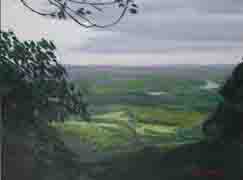first peoples
First Explorations
Retreating glaciers 10,000 years ago left behind a river that cut into layers of sediment, creating a series of wide, fertile terraces over which eventually grew a vast forest of oak, pine, hickory, and chestnut. Native Americans first came to the region following animal herds, but the geography was so welcoming that they soon made more permanent homes along the river, farming maize and squash, hunting, and fishing. Because the lowest terraces were vulnerable to flooding, Native Americans and later European settlers built their villages on the second terraces, with farm fields below. By the time Europeans arrived in the valley in 1614, Native Americans had been regularly burning the forest undergrowth and farming in the region for centuries. Most European towns were laid out on land that had been previously cleared by Native Americans. The expansive forests that covered the valley in the seventeenth century encouraged the wasteful use of wood, and by the turn of the nineteenth century nearly sixty percent of the land in the valley was being used for farms and pastures.
Europeans drastically changed the ecology of the valley, both by transforming the landscape from forests to cultivated grasslands and by hunting many animal species to near extinction. By the turn of the nineteenth century, caribou, elk, buffalo, moose, cougars, beavers, blue herons, and black bears were gone from the valley. By 1850, wolves and cougars were gone from Massachusetts, and Europeans had hunted the heath hen and passenger pigeon to extinction. The change in the valley's ecology also encouraged the spread of meadow-dwelling species, like the meadowlark, whippoorwill, fox, bog turtle, and eastern cottontail. Meanwhile, the coyote radically expanded its range, taking the place of the wolf and the cougar as the main large predator in the Connecticut River Valley.
During the mid-nineteenth century, many farmers left Massachusetts for the more fertile fields of the Midwest, and industrialists began to use the Connecticut River to generate energy for mills and factories. As the resulting industrial centers of Springfield and Holyoke came to dominate the economy of the region, the valley's landscape began to change again. Springfield and Holyoke expanded over what had once been farmland, and forests reclaimed empty fields.
Today, New England as a whole has more forested territory than at any other time since the American Revolution. Though the rich soil of the Connecticut River Valley has kept it a regional farming center, only ten percent of the land in the valley is now used for farming. The forests of today are not dominated by oak and chestnut, but by faster growing species, such as maple, ash, cherry, poplar, and pine. Despite these changes in composition, the forests' revitalization has meant the return of many animal species, such as beaver, bear, and wild turkey. The number of meadow-dwelling species has decreased with the expansion of suburban developments, which also encroach on wetlands and farms. Thus, centuries of ecological change in the Connecticut River Valley continue as a consequence of both natural and human forces.
